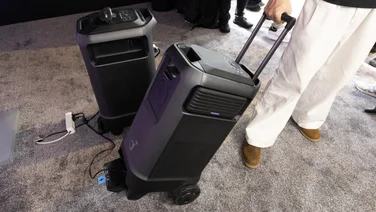To help us provide you with free impartial advice, we may earn a commission if you buy through links on our site. Learn more

Z-Wave is a wireless radio system that’s used by many smart home devices. Sure, Wi-Fi rules the roost for browsing the web, and Bluetooth’s great for hooking up headphones and wearables, but smart home tech needs a low-power, always-on system that can reach from one end of your home to the other.
There are two major standards used by smart lighting, heating and security devices (not to mention smart appliances and automation controllers), known as Z-Wave and Zigbee. You can find out all about Zigbee here – or read on for our guide to all things Z-Wave, along with our pick of the best Z-Wave devices for your smart home.
Where did Z-Wave come from?
Z-Wave was originally designed way back in 1999 by the Danish company Zensys, as a simple, affordable, general-purpose alternative to the proprietary home automation systems that were starting to emerge. Since then it’s gained the support of over 700 home electronics companies and brands, including Samsung SmartThings, ADT, August, Huawei, LG, Silicon Labs, Ingersoll and General Electric. Today there are more than 2,600 different certified Z-Wave products on the market, all designed to be interoperable with each other.
How does Z-Wave work?
Z-Wave is purpose-built to connect smart home devices to each other, and to the smart hubs that manage them. You can find it in smart switches, sensors, thermostats and more. It uses much less power than Wi-Fi or regular Bluetooth, but can still connect devices across a good-sized house.
It does this in the same way as Zigbee – by using a mesh topology. That means that, rather than each device having to connect directly to a router or hub, Z-Wave devices can relays packets of data back and forth among themselves. So it’s no problem if your Z-Wave lightbulb is a long way from the hub: the signal can hop through sensors and appliances in-between to get where where it needs to go.
This arrangement makes Z-Wave slower than Wi-Fi, but much more flexible. The range of your network grows organically as you install more Z-Wave devices, and it also becomes more resilient, with an increasing number of ways for data packets to travel from one point to another.
Why does Z-Wave matter?
The mesh design is clever, but there’s more to Z-Wave than this: all products using the technology have to be independently tested and certified to work together. This ensures that all your Z-Wave devices, regardless of who made them, can be controlled from one place, so that you can (for example) simultaneously set the lighting, heating and security using a single routine when you leave the house.
Z-Wave certification also guarantees certain security standards. Its latest S2 security frameworks include advanced features designed to protect against hackers and privacy breaches, using 128-bit AES encryption and anti-intrusion measures. This is a crucial part of Z-Wave, as it’s used by many security manufacturers, including ADT and Abode: clearly, the last thing you want is a vulnerable system that could allow a criminal to deactivate your smart locks and alarms.
Is Z-Wave the same as Zigbee?
In practice Z-Wave and Zigbee are very similar, but there are some notable differences. One is that Zigbee uses the same 2.4GHz radio band as Wi-Fi and Bluetooth networks, which could lead to interference issues. Z-Wave, by contrast, receives and transmits on a much lower frequency band – 868.42MHz in Europe, and 908.4MHz in the Americas. That should rule out any such problems, and it also helps Z-Wave handle longer distances between devices than Zigbee.
Historically, Z-Wave has also offered better interoperability, while Zigbee implementations have differed from manufacturer to manufacturer. Zigbee is catching up, however, as more and more companies adopt the latest Zigbee 3.0 protocol.
Zigbee does have some advantages: the Z-Wave protocol supports a maximum of 232 devices on your network, while Zigbee can run into the thousands. And while Z-Wave is strong in the US, here in the UK you’re more likely to find Zigbee in smart lighting and heating products, thanks to support from big European manufacturers like Philips and IKEA. There’s also a Zigbee hub conveniently built into the Amazon Echo Plus, whereas Z-Wave requires a separate controller such as the Samsung SmartThings Hub or the Logitech Harmony Hub.
READ NEXT: The best smart bulbs and lighting systems
The best Z-Wave smart home devices 2019
1. Samsung SmartThings Hub
Price: £80 | Buy now from Amazon

There are cheaper Z-Wave hubs on the market, but Samsung’s SmartThings Hub has one big advantage: it works with Zigbee as well as Z-Wave (and Samsung’s own SmartThings platform). That means you can get all the benefits of Z-Wave, while also using Zigbee where it’s more convenient, such as for light bulbs and power outlets. There’s support for Alexa and the Google Assistant too: connect your SmartThings Hub to an Echo Dot or Google Home Mini and you can use voice commands to control your smart devices.
2. Fibaro Gen5 Z-Wave Wall Plug
Price: £55 | Buy now from Vesternet

Fibaro’s compact smart plug is a lot more stylish than the cheap Wi-Fi sockets you’ll see on Amazon, and it’s also a lot smarter. Rather than merely turning the connected appliance on and off, this plug can monitor and report on its power usage, with the LED ring around the plug changing colour to give you a live, at-a-glance indication of how much juice is being consumed. It also has a built-in Z-Wave range tester, so you can check the quality of the connection in all parts of your home.
3. Aeotec WallMote Quad
Price: £50 | Buy now from Amazon

Most smart lighting systems put the brains in the bulbs; Aeotec takes a different approach with this sophisticated wall-mounted switch. Its four touch panels are gesture-sensitive, allowing you to access any one of 16 different scenes with a simple swipe. And these aren’t just limited to lighting: if your house is kitted out with the right Z-Wave gear, you can create instant-access programmes combining lighting, heating and security settings. The futuristic looks are the icing on the cake.
4. Fibaro Gen5 Z-Wave Motion Sensor
Price: £46 | Buy now from Amazon

Motion sensors are great for smart home systems: they can turn the lights on when you come home, turn them off when they’re not needed, and trigger alarms if something happens while you’re out. Fibaro’s sensor is battery-powered and fits into a neat cradle which screws discreetly onto a wall – and in addition to motion it’ll detect light intensity, temperature and vibrations. It looks like a plain white orb while idle, but flashes with a cool illuminated cat’s-eye effect when it’s paired or activated.
5. Aeotec Z-Wave LED Bulbs
Price: from £35 | Buy now from Amazon

The major smart lighting brands tend to use Zigbee – but if you’re looking for Z-Wave bulbs, Aeotec has you covered, with dimmable white models for around £33 and multi-colour ones for around £45. They’re designed to last for around 25,000 hours, equivalent to 10 years of being switched on for six hours a day, and the multi-colour ones have a huge range of 16 million different hues, with brightness levels up to 800 lumens. You’ll need an adaptor if you have B22 bayonet-type sockets though, as they’re only available with a screw-in E27 base.
6. Yale Keyless Connected Smart Door Lock
Price: £95 plus £42 for Z-Wave module | Buy now from Amazon

If you’re always losing your keys, Yale’s keyless lock could be the perfect answer. The standard unit attaches easily to your front door, and can be opened with a key fob, a key card or a six-digit passcode. Add the optional Z-Wave module and it becomes a smart lock, which you can open from a smartphone app or integrate into a routine – so you can, for example, issue a single voice command to turn the lights off and lock the door behind you as you leave.











